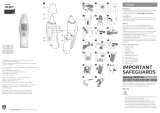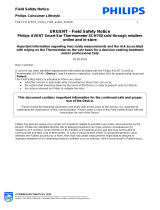
Measuring the temperature of older children
For older children and adults, the digital thermometer can also
be used to measure temperature orally (in the mouth) or axially
(in the armpit).
- How to measure the temperature orally: Place the
tip of the thermometer under your child’s tongue.
Note: Make sure your child seals its lips.
- How to measure the temperature axially: Place the
tip of the thermometer in your child’s armpit. Press its arm
against its body and hold its elbow to keep the thermometer
in place.
Note: Make sure your child’s armpit is dry.
Do not use the digital thermometer for oral or axial
temperature measurements on babies.
After using the digital thermometer rectally or in the armpit, do
not use it for oral measurement for hygienic reasons,
not even after cleaning.
Audible signals
1 beep per second: Temperature is normal (<37.8°C).
3 beeps per second: Possible fever (>37.8°C).
Note: The thermometer only indicates fever. It does not beep
when your child’s temperature is below normal.
Features
Last temperature recall
The digital thermometer has a memory function. When the digital
thermometer is switched on, the display automatically shows the
last measured temperature for approx. 2 seconds.
The display then shows the normal body temperature of 37°C.
Battery-low indication
Batteries can last for about 2 to 3 years. If the display shows
a battery symbol
, the battery is low. Replace the battery
(see section ‘Replacing the battery’).
Error function
In case of malfunction, the display shows ‘Err’. Proceed as follows
if this happens:
1 Press I to reset the digital thermometer.
Replacing the battery
Batteries may explode if exposed to high temperatures or re.
Never attempt to recharge the battery.
If the display shows a battery symbol, the battery is low. Replace
the battery of the digital thermometer as described below.
1 Replace the battery of the digital thermometer using a small
at-blade screwdriver. See illustrations g. 8, 9, 10 and 11.
2 Dispose the battery properly (see chapter ‘Recycling’).
Cleaning
Be careful not to damage the parts when you clean the digital
thermometer.
1 Use warm water and some washing-up liquid.
Do not use abrasive cleaning agents, anti-bacterial cleaning
agents or chemical solvents. Excessive concentration of cleaning
agents may eventually cause plastic components to crack. Do
not use cracked parts.
Storing
1 Put the protection cap on the digital thermometer after
use and store it in a dry place.
Technical specications
Digital thermometer
Battery 1.55VDC (LR41 or SR41)
Battery life > 100 operating hours
Measurement range 32°C to 42.9°C
Accuracy ± 0.1°C for 35°C to 42°C range
Compliance Conforms to MDD93/42/EEC
Storage temperature -20°C to 60°C / -4°F to 140°F
Humidity level 15% to 95% RH
Atmospheric pressure 700hpa - 1060hpa
Nasal aspirator
1 Hold the baby upright when you use it.
2 Squeeze the aspirator bulb and place the tip gently into
the baby’s nostril and tilt the tip to the side.
3 Release the bulb slowly to let the suction draw mucus out
of the baby’s nose.
4 Repeat the process with the other nostril.
Never use the nasal aspirator in the baby’s mouth or ears.
Do not insert the aspirator into the baby’s nose too far.
Never point the tip directly in the centre of the nostril.
Cleaning
1 Disassemble all parts of the nasal aspirator and wash them
in warm water with washing-up liquid.
2 Sterilise the nasal aspirator in boiling water for 10 min.
and dry it afterwards.
Finger toothbrush
1 Place the nger toothbrush on your ngertip to massage
the baby’s gums gently.
Cleaning
1 Sterilise with a steriliser or boiling water. Let it cool down
and dry.
Brush and comb
1 Brush/comb the baby’s hair from root to tip.
Tip: Carefully keep a hand on the roots while brushing or combing to
avoid pulling the baby’s scalp.
Cleaning
1 Clean with warm water and some washing up liquid,
rinse them thoroughly and let them dry.
Nail cutter and scissors
Be careful not to cut the nails too close to the baby’s skin.
Tip: We advise you to cut the baby’s nails after a bath when the nails
are soft, or when the baby sleeps.
Cleaning
1 Wipe the nail cutter and the scissors with a damp cloth
and dry them.
Note: You can sterilise the nail cutter and the scissors by wiping their
cutting edges with alcohol.
Emery boards
1 Gently glide the emery board across the baby’s nails.
Pouch
Save all items in the pouch, and store them in a dry place.
Recycling
- This symbol means that this product shall not be disposed of
with normal household waste (2012/19/EU) (Fig. 12).
- This symbol means that this product contains batteries
which shall not be disposed of with normal household waste
(2006/66/EC). The chemical symbol ‘Pb’ shown below the
wheeled bin means that the battery contains lead. (Fig. 13)
- Follow your country’s rules for the separate collection of
electrical and electronic products and batteries. Correct
disposal helps prevent negative consequences for the
environment and human health.
Removing disposable batteries
To remove disposable batteries, see the instructions for placing
and/or removing batteries in this user manual, chapter ‘Digital
thermometer (SCH410)’, section ‘Replacing the battery’.
Guarantee and support
If you need information or support, please visit www.philips.com/
support, or for the digital thermometer, read the separate
worldwide guarantee leaet.
ČEŠTINA
Důležité
Blahopřejeme vám k nákupu a vítáme vás ve společnosti Philips.
Abyste mohli plně využít podpory, kterou Philips poskytuje,
zaregistrujte svůj výrobek na webu www.philips.com/
welcome. Pozorně si přečtěte tuto uživatelskou příručku
a uschovejte si ji pro budoucí použití.
Varování
- Osoby (včetně dětí) s omezenými fyzickými, smyslovými
nebo duševními schopnostmi nebo nedostatkem zkušeností
a znalostí by neměly s digitálním teploměrem manipulovat,
pokud nebyly o používání přístroje předem poučeny
nebo nejsou pod dohledem osoby zodpovědné za jejich
bezpečnost.
- Digitální teploměr nikdy nesterilizujte ve vařící vodě.
- Nebezpečí spolknutí baterií! Digitální teploměr
obsahuje knoíkovou baterii. Pokud knoíkovou baterii
náhodou spolknete, může způsobit vážné vnitřní popáleniny
během pouhých 2 hodin a dokonce zapříčinit smrt.
- Kryt přihrádky baterie digitálního teploměru je třeba po
vyjmutí vždy řádně nasadit zpět. Pokud by byl volný, mohlo
by se jím dítě udusit.
- Tyto výrobky obsahují součásti s ostrými hranami a malé
součástky.
Tyto výrobky nejsou hračky. Nedovolte dětem, aby
si s nimi hrály. Když se výrobky nepoužívají, udržujte je mimo
dosah dětí.
- Nikdy nenechávejte dítě s těmito výrobky bez dozoru.
- Před každým použitím a po něm všechny výrobky očistěte.
Viz část „Čištění“.
- Žádný výrobek nečistěte agresivními rozpouštědly nebo
chemikáliemi.
- Neskladujte ani nenechávejte žádný výrobek na přímém
slunci nebo v blízkosti zdroje tepla.
Upozornění týkající se digitálního teploměru
- Digitální teploměr je vhodný pro děti a dospělé každého věku.
- Digitální teploměr je vhodný k použití při pokojových
teplotách mezi 10° a 35°C.
- Digitální teploměr nepouštějte na zem a nevystavujte jej
silným nárazům.
- Hrot digitálního teploměru neohýbejte ani nerozebírejte.
- Digitální teploměr nepoužívejte, je-li na displeji symbol
baterie. Tento symbol znamená, že baterie je slabá a měření
budou nepřesná.
- Při orálním měření teploty nekousejte do kovového hrotu.
Jednoduše vložte hrot teploměru pod jazyk.
Symboly na digitálním teploměru
1 Tento symbol znamená: Přečtěte si tuto příručku (Obr. 1).
2 Tento symbol určuje aplikovanou část BF, která je v souladu
s normou IEC60601-1 (Obr. 2).
3 Tento symbol znamená: Je v souladu se směrnicemi EU.
Značka CE znamená „Conformité Européenne“ (evropská
shoda). 0344 je číslo notikovaného orgánu (Obr. 3).
4 Tento symbol znamená: Chráněno před přístupem
k nebezpečným součástem pomocí prstů a proti svisle
padajícím vodním kapkám (Obr. 4).
5 Tento symbol znamená: skladovací teplota (Obr. 5).
6 Tento symbol znamená: relativní vlhkost (Obr. 6).
7 Tento symbol znamená: atmosférický tlak (Obr. 7).
Elektromagnetická pole (EMP)
Digitální teploměr Philips AVENT odpovídá všem platným normám
a předpisům týkajícím se vystavení elektromagnetickým polím.
Digitální teploměr (SCH410)
Digitální teploměr měří tělesnou teplotu vašeho dítěte rektálně
(v konečníku), axiálně (v podpaží) nebo orálně (v ústech).
Poznámka: Otestujte na 10 sekund v koupelové vodě.
Poznámka: Výsledky se mohou lišit v závislosti na jednotlivci a použité
metodě.
Poznámka: Pro zajištění nejvyšší přesnosti doporučujeme
rektální měření.
Poznámka: Hodnoty orálního a axiálního měření jsou obvykle o
0,5 až 1 °C nižší než skutečná tělesná teplota.
Dětská teplota
Dětská teplota je normálně 36,5 až 37,5 °C. Mějte však na paměti, že
se mění v závislosti na věku, aktivitě, denní době apod. Nezapomeňte
také, že u některých nemocí není symptomem vysoká teplota. Měření
teploty by nemělo nahradit návštěvu lékaře. Při hlášení dětské teploty
odborníkovi udejte, jakou metodou jste ji změřili.







